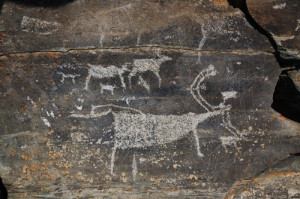Devlet E.G.
Institute of Archaeology RAS (eketek@yandex.ru)
Key words: petroglyphs, rock art, Chukotka.
 Petroglyphs of the northernmost in Asia rock art site were created on the Kaikuul Bluff which stretches along the Pegtymel river some 40–50 km from the coast of the East Siberian Sea. Numerous petroglyphs are located on sandstone vertical cliffs, on separate stones and in a small shelter. The vast majority were pecked, there were also figures with the elements of abrasion and engraving. The field research in 2000-s by the team from the Institute of Archeology Russian Academy of Sciences has added considerably to the rock art collection from Northern Asia. There were identified more than 350 panels, they have been recorded. An innovative aspect of the research was the traceological program involving the study of petroglyphs’ techniques and the material of the tools used for their pecking. By the result of the Pegtymel experiments the main diagnostic feature distinguishing pecking pits left by a stone punch tool from the iron tool traces was the quick change of the work area of a stone tool, the pecked traces showed a dynamic transformation from the sub-rounded or sub-quadrangular pits to the linear elongated ones. Another important feature of the use of stone tools was the wide entrance hole and the lack of sharp drops between the peaks and depressions. Comparison of the experimental stone tools reference materials with the rock art demonstrated that only a small part of the petroglyphs had comparable pecking.
Petroglyphs of the northernmost in Asia rock art site were created on the Kaikuul Bluff which stretches along the Pegtymel river some 40–50 km from the coast of the East Siberian Sea. Numerous petroglyphs are located on sandstone vertical cliffs, on separate stones and in a small shelter. The vast majority were pecked, there were also figures with the elements of abrasion and engraving. The field research in 2000-s by the team from the Institute of Archeology Russian Academy of Sciences has added considerably to the rock art collection from Northern Asia. There were identified more than 350 panels, they have been recorded. An innovative aspect of the research was the traceological program involving the study of petroglyphs’ techniques and the material of the tools used for their pecking. By the result of the Pegtymel experiments the main diagnostic feature distinguishing pecking pits left by a stone punch tool from the iron tool traces was the quick change of the work area of a stone tool, the pecked traces showed a dynamic transformation from the sub-rounded or sub-quadrangular pits to the linear elongated ones. Another important feature of the use of stone tools was the wide entrance hole and the lack of sharp drops between the peaks and depressions. Comparison of the experimental stone tools reference materials with the rock art demonstrated that only a small part of the petroglyphs had comparable pecking.







